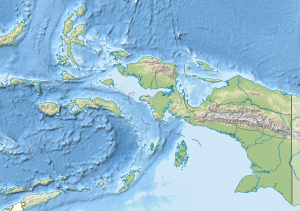Kei Besar
| Kei Besar | ||
|---|---|---|
| Waters | Banda Lake , Arafura Lake , Seramsee | |
| Archipelago | Kei Islands | |
| Geographical location | 5 ° 40 ′ S , 133 ° 1 ′ E | |
|
|
||
| surface | 550 km² | |
Kei Besar ( Kai Besar , locally: Nuhu Yuut or Nusteen ) is a 550 km² island of the Kei Islands in the Moluccas archipelago . The northern part of the island is called Tanjung Borang and the southern part is called Tanjung Wedua .
geography
Kei Besar is the easternmost of the Kei Islands. To the west, across the Nerong Strait, lie the main islands of the archipelago, Kei Kecil and Kei Dullah . Kei Besar belongs to the administrative district ( Kabupaten ) Maluku Tenggara of the Maluku province . The center and northwest form the district ( Kecamatan ) Kei Besar with Nuhuyanan and three other offshore islands: Wat , Nota and Karod . The main town is Elat . The district of Kei Besar Utara Timur with the main town Hollat is located in the northeast of the island. The district of Kei Besar Selatan with the main town Weduar is located in the south. The offshore islands are Masular , Aran Laai , Aran Kot , Dufin and Nasu Lar .
Residents
The native population is made up of Melanesians who have mixed with Malay ethnic groups. Land mostly belongs to the village community and arable land to the person who cultivates it. The inhabitants of Kei Besar traditionally speak the Austronesian language Kei ( Saumlaki, Veveu Evav ). The majority of the population is of Roman Catholic faith, and some are also Muslim.
The old Bandanese language is spoken in the villages of Banda-Eli ( Wadan El ) and Banda-Elat ( Wadan Elat ) to the west and northeast of Kei Besar . Immigrants brought the language with them from the Banda Islands . They had been driven from their old homeland by the Dutch in the 17th century. There the language died out. It differs significantly from the other languages of the South Moluccas . The majority of the Banda speakers are Muslim.
history
In 1900 the Protestant Indian Kerk of Ambon began missionary work on the Kei Islands. In 1905 they founded their center in the archipelago in Elat.
From March to June 1999 there was fighting between Christians and Muslims in the Kei Islands. They first started in Tual , the district capital on Kei Dullah, and then spread to Elat. A dispute between a Protestant and a Muslim politician probably led to an attack by residents of the Christian Weduar Feer (Kei Besar Selatan) on the Muslim village of Larat . Several neighboring villages were drawn into the fighting, which then spread along the coast of Kei Besar and then on to Kei Kecil. The unrest did not end until June. A total of 200 people were killed in the Kei Islands, 30,000 people (a quarter of the total population of the Kei Islands) were displaced and 4,000 buildings were destroyed. Malaria and other diseases claimed more victims in the refugee camps.
Web links
Individual evidence
- ↑ Penduduk Indonesia menurut desa 2010 ( Memento from March 27, 2014 in the Internet Archive ) (Indonesian; PDF; 6.0 MB), accessed on January 26, 2013
- ↑ a b Encyclopedia Britannica
- ^ Language map of the Moluccas and West Papua
- ↑ a b Ethnologue: Kei
- ↑ Ethnologue: Banda
- ↑ a b Musibah: Entitlements, Violence and Reinventing tradition in the Kei Islands, Southeast Maluku, Paper submitted for the International Association for the Study of Common Property 9th Biennial Conference, Victoria Falls, Zimbabwe

